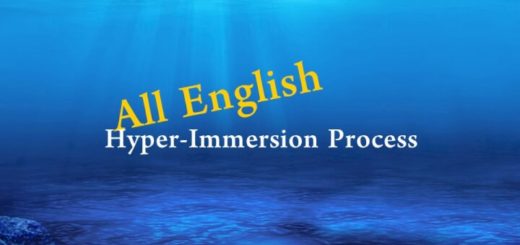The Value of Immersion
There’s no doubt about it, language immersion is effective in learning a second language. It is used extensively in the school systems in Canada and has been quite successful. What makes immersion in school more effective than general immersion is that it provides lots of rich thematic content (history, geography, math, etc.) as comprehensible input. With general immersion, on the other hand, you get exposed to very little language and the exposure happens in a very random way, so that language patterns are not well reinforced.
The All English learning system utilizes the power of immersion with the benefit of providing meaningful, thematic content. Furthermore, the language is introduced in a graduated way, so that the meaning of the language is always understood.
Here are some takeaways from a report on the value of immersion programs , particularly in school settings:
Second language instruction that is integrated with instruction in academic or other content matter is a more effective approach to teaching second languages than methods that teach the second language in isolation. Research has shown consistently that immersion students acquire functional proficiency in French, or in other second languages, that surpasses that of students in all other forms of second language instruction to which immersion has been compared. The integration of language instruction with content instruction is the hallmark of the immersion approach.
There is an important contrast between the integrated approach used in immersion and the conventional grammar-based approaches used in some other programs. In immersion, second language teaching is embedded in a rich and meaningful communicative context. The goal of learning language is not grammatical perfection, but meaningful communication among students and teachers. Students remain motivated to learn the second language when they have a sense of academic accomplishment and of increasing competence in using the second language for communicative purposes.
Language is acquired most effectively when it is learned for communication in meaningful and significant social situations. In life at large, people use language to communicate what they know, what they want to know, and their feelings, and desires.
The content of integrated second language instruction need not be academic; it can include any topic, theme, or non-language issue of interest or importance to the learners. Important and interesting content, academic or otherwise, provides students with a meaningful basis for understanding and acquiring new language structures and patterns. Similarly, authentic classroom communication, about matters of academic or general interest to the students, provides a purposeful and motivating context for learning the communicative functions of the new language.
Research has shown that immersion students often perform as well as native French-speaking students on tests of reading and listening comprehension in French. However, they seldom achieve the same high levels of competence in speaking and writing as they achieve in comprehension. The available research evidence suggests that students in many immersion classes are given few chances to speak during class and even fewer opportunities to initiate the use of language. Most often, students use language in response to questions or comments initiated by the teacher.
Other studies indicate that students who have extended opportunities for classroom discourse in the target language, even with other nonnative speakers, are at an advantage for acquiring language production skills.
The second lesson to emerge from research on immersion is that integrated second language approaches that provide opportunities for extended student discourse, especially discourse associated with activities selected by individual students, can be particularly beneficial for second language learning [specifically production] in school settings.
That late immersion students can attain the same levels of second language proficiency as early immersion students, despite significantly less exposure to the target language, attests to the general cognitive maturity and learning efficiency of older learners.












